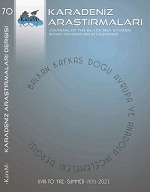RUS DİLİNİN EDATLI BİRLEŞİK CÜMLE YAPILARININ TÜRKÇEYE AKTARIMINDA UYGULANABİLECEK ÇEVİRİ STRATEJİLERİ
SOME TRANSLATION STRATEGIES FOR CONVEYING COMPLEX SENTENCE STRUCTURES WITH PREPOSITIONS FROM RUSSIAN INTO TURKISH
Author(s): Leyla Çiğdem DalkılıçSubject(s): Syntax, Eastern Slavic Languages, Translation Studies, Turkic languages
Published by: Karadeniz Araştırmaları Merkezi
Keywords: Syntax; Complex Sentence; Connector Word; Translation Strategies; Russian-Turkish;
Summary/Abstract: This study examines complex sentences [in Russian] formed using the connector word “который” – which conveys different semantic relationships, especially multiple prepositions in the sentence are involved. It also analyses the difficulty of translating these types of sentences from Russian into Turkish, and provides examples of such. Such a construction mainly exists in written Russian only, and requires its normative usage. As it is prevalent in Russian business writing and journalism, we’ve also briefly touched how it is used in both contexts. The subordinate part of such a construction - with the help of the connector – contains information about the main sentence. Thus, it contributes to the integrity of the expression. In Russian linguistics, these traditionally referred to as linking sentences. However, many studies on Russian syntax refer to them under a different guise. There are a number of reasons why these sentences are difficult to translate into Turkish: One, the main elements of the main sentence performs a different function in the subordinate clause. Two, the continuation of the sentence becomes more difficult. Three, you have to take the connector and the meanings of various prepositions into account. This will analyse these difficulties of translating such sentences. Our objective is to compare/contrast how such sentences take shape in both languages and present possible ways to approach translating them. We have also attempted to identify problems that students of Russian as a foreign language ought to pay attention to when they encounter similar sentence structures and guide them through how to translate them.
Journal: Karadeniz Araştırmaları
- Issue Year: 2021
- Issue No: 70
- Page Range: 401-418
- Page Count: 18
- Language: Turkish

